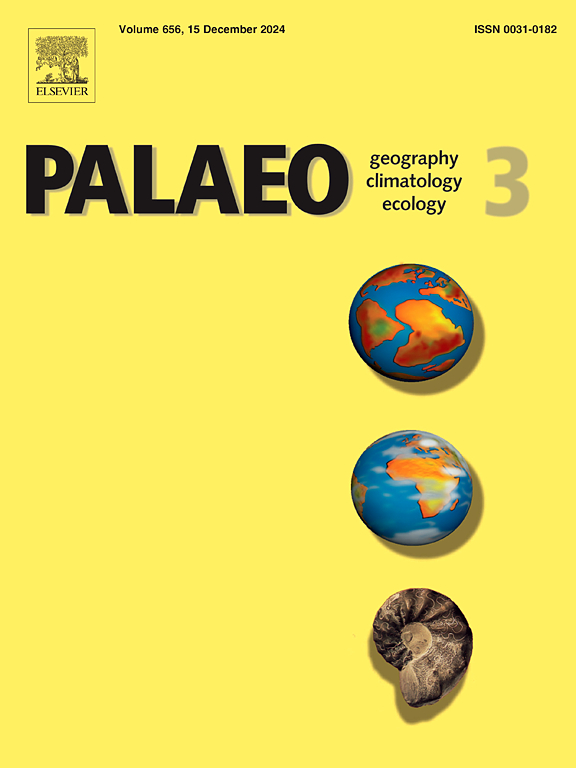在控制的水族馆环境中,以每日分辨率记录十年砗磲蛤的硬化化学-栖息地变化,诱导的季节性和生长变异的记录
IF 2.7
2区 地球科学
Q2 GEOGRAPHY, PHYSICAL
Palaeogeography, Palaeoclimatology, Palaeoecology
Pub Date : 2025-05-17
DOI:10.1016/j.palaeo.2025.113022
引用次数: 0
摘要
巨蛤(如砗磲sp.)的壳迅速增加(毫米厘米/年),长达十年的寿命和文石壳,是宝贵的(古)环境档案,可能提供(亚)季节时间尺度的信息。荷兰阿纳姆的皇家汉堡动物园水族馆在2000年开设了一个活珊瑚礁生态展览,并于2001年从越南引进了T. squamosa。2011年死亡的一个标本(TS2)促进了长达十年的精心监测的水族馆条件与砗磲的硬化化学和生长的比较,我们在此介绍其结果。LA-ICPMS的空间分辨El/Ca比值(可达日分辨率)以及微磨δ13C和δ18O数据被转移到日分辨率的硬化年代框架中,从而实现了水缸参数与硬化化学的详细关联。我们发现,从2009年开始,运输、引入新的水族馆环境、水变化制度的变化和人工季节性等环境压力对生物的生长和硬化化学产生了严重影响,并在该样品中表现为Mg/Ca和Sr/Ca比值的增加。在运输到水族箱期间,生长速率从~ 20 μm/天降低到~ 7 μm/天,在水族箱中换水期间,生长速率从~ 10 μm/天降低到~ 2 μm/天。在运输诱导的应激过程中,每日El/Ca循环被破坏,但在引入后的三周内,生物体适应了水族馆,并恢复了自然生长速度和循环。三年的温度季节性(25.0-26.5°C)对Na/Ca的影响最为显著,而由于TS2的生长速率急剧下降,加上我们的取样钻孔步长较大,因此无法解决预期的δ18O变异。尽管由于意外的过度受精,水族箱中[no -3]从~ 0.02 mg/L短暂飙升至2.4 mg/L,但对生物体的硬化化学或生长速度没有明显的应激影响。水交换机制的变化似乎具有更大的硬化化学影响,因为这些影响反映在总体δ18O、Ba/Ca和相关的增长率上。长达十年的详细三砗磲记录表明,即使环境变化相对较小的系统也能产生很大程度的壳非均质性,这也强调了建立一个详细的(计数的)年表对硬化化学解释的重要性。本文章由计算机程序翻译,如有差异,请以英文原文为准。
Ten years of Tridacna sclerochemistry at up to daily resolution from a controlled aquarium environment – Records of habitat change, induced seasonality and growth variability
Giant clams such as Tridacna sp., with their rapid shell accretion (mm-cm/year), decade-long lifespans and aragonitic shells, are invaluable (palaeo)environmental archives, potentially providing information at (sub-)seasonal timescales. Royal Burgers' Zoo aquarium in Arnhem, The Netherlands, opened a live coral reef eco-display in 2000 and introduced T. squamosa from Vietnam in 2001. One specimen (TS2) that died in 2011 facilitated a decade-long comparison of carefully monitored aquarium conditions with Tridacna sclerochemistry and growth, whose results we present herein. Spatially resolved El/Ca ratios by LA-ICPMS (at up to daily resolution) as well as micromilled δ13C and δ18O data were transferred onto a sclerochronological framework at a daily resolution, which enabled the detailed correlation of aquarium parameters with sclerochemistry. We show that environmental stresses such as transportation, introduction to a new aquarium environment, shifts in water change regimes and artificial seasonality from 2009 onwards have severe impacts on the organism's growth and sclerochemistry, and are particularly manifest in this sample in increased Mg/Ca and Sr/Ca ratios. Growth rates were reduced from 20 to 7 μm/day during transportation into the aquarium, and from 10 to 2 μm/day during shifts in water change regimes in the aquarium. A disruption of daily El/Ca cyclicity was marked during transportation-induced stress, but within three weeks of introduction the organism acclimatised to the aquarium and returned to natural growth rates and cyclicity. Three years of induced temperature seasonality (25.0–26.5 °C) most notably affected Na/Ca, while the resulting expected δ18O variability was not resolvable due to TS2's strongly decreased growth rate coupled with our large drill-step size for sampling. Despite a transient spike in aquarium [NO-3] from 0.02 to 2.4 mg/L, caused by accidental over-fertilisation, no stress effect was apparent in the organism's sclerochemistry or growth rate. Changes in the water-exchange regime appear to have far more sclerochemical impact, as these are reflected in the overall δ18O, Ba/Ca and associated growth rates. The detailed decade-long Tridacna record shows that even systems with comparatively little environmental variability can produce large degrees of shell heterogeneity, and also highlights the importance of establishing a detailed (counted) chronology for sclerochemical interpretations.
求助全文
通过发布文献求助,成功后即可免费获取论文全文。
去求助
来源期刊
CiteScore
5.90
自引率
10.00%
发文量
398
审稿时长
3.8 months
期刊介绍:
Palaeogeography, Palaeoclimatology, Palaeoecology is an international medium for the publication of high quality and multidisciplinary, original studies and comprehensive reviews in the field of palaeo-environmental geology. The journal aims at bringing together data with global implications from research in the many different disciplines involved in palaeo-environmental investigations.
By cutting across the boundaries of established sciences, it provides an interdisciplinary forum where issues of general interest can be discussed.

 求助内容:
求助内容: 应助结果提醒方式:
应助结果提醒方式:


